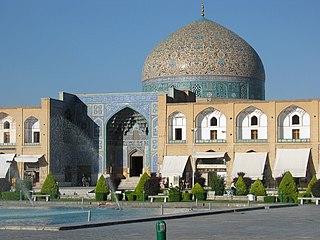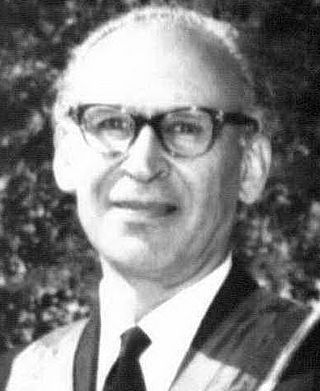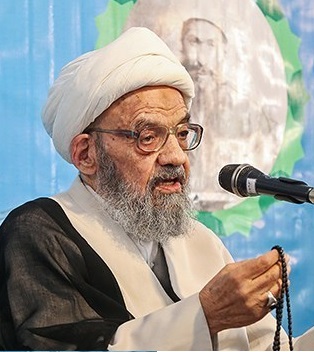
Tehran province is one of the 31 provinces of Iran. Its capital is the city of Tehran.

Mohammad Yazdi was an Iranian conservative and principlist cleric who served as the head of Judiciary System of Iran between 1989 and 1999. In 2015, he was elected to lead Iran's Assembly of Experts, defeating Akbar Hashemi Rafsanjani, a former president, by a vote count of 47 to 24.

Sheikh Lotfollah Mosque is one of the masterpieces of Iranian architecture that was built during the Safavid Empire, standing on the eastern side of Naqsh-i Jahan Square, Esfahan, Iran. Construction of the mosque started in 1603 and was finished in 1619. It was built by the chief architect Mohammadreza Isfahani, during the reign of Shah Abbas I of Persia. On the advice of Arthur Upham Pope, Reza Shah Pahlavi had the mosque rebuilt and repaired in the 1920s.

Abbās Ābād is a large north-central neighborhood of Tehran, Iran, designated within the Seventh Municipal District of the capital.

Sayyid Mahmoud Alaei Taleghani was an Iranian theologian, Muslim reformer, democracy advocate, a senior Shia Islamic scholar and thinker of Iran, and a leader in his own right of the movement against Shah Mohammad Reza Pahlavi. A founding member of the Freedom Movement of Iran, he has been described as a representative of the tendency of many "Shia clerics to blend Shia with Marxist ideals in order to compete with leftist movements for youthful supporters" during the 1960s and 1970s. His "greatest influence" has been said to have been in "his teaching of Quranic exegesis," as many later revolutionaries were his students.

City Park, with its 26 hectares, is an urban park located in the central Tehran, Iran. It is the first public park in Tehran. City Park surrounded by Fayaz Bakhsh Street from the north, Hafez Street from the west, Behesht Street from the south and Khayyam Street from the east.

Tehran–Qom–Isfahan high-speed rail is the first truly high-speed rail project in Iran. Construction began on 25 February 2015. The rail line would decrease travel times between Tehran and Isfahan, passing through Qom. It connects Isfahan and Qom to Imam Khomeini International Airport.

Elham Fakhari is a psychologist, Politician, writer, painter, poet, member of the Central Council of the National Trust Party, and a former member of the City Council of Tehran, Ray, and Tajrish.

Koohsar Shahran Park is a forest park located in shahran, northern Tehran, Iran. It covers an area of about 10 square kilometers, and includes ramps and facilities for cycling and skating. Koohsar Shahran Park has 2 main entrances, One on Koohsar Boulevard and another on Shahran Boulevard. Also, Koohsar Shahran is Tehran's largest forest park. Due to the clean air, many people in Tehran come to Koohsar Shahran Park for walking and sport activities.

Jameh Mosque of Tehran is the oldest mosque in Tehran, with its oldest Shabestan, more than a thousand years old, and is also known as the Atiq Mosque.

Mehdi Bayani was the founder and the first head of the National Library of Iran, specialist in Persian manuscripts and calligraphy, writer, researcher, and professor at the University of Tehran.

Seyed Abdol Javad Alamolhoda was an Iranian ayatollah. He was the older brother of Ahmad Alamolhoda, the Friday prayer leader in Mashhad. He was also the founder of Al-Qaim Seminary in Tehran.

Sheikh Nasrallah Shah-Abadi Persian: شیخ نصرالله شاه آبادی, was an Iranian Ayatollah. He represented the people of Tehran Province in the Fifth term of the Assembly of Experts.

Sheikh Ahmad Mohseni Garakani Persian: شیخ احمد محسنی گرکانی, is an Iranian Ayatollah. He was the Imam of Friday Prayer in Tuyserkan and the Chief of the Supreme Court of Iran, as well as representing the people of Markazi province in the Assembly of Experts from 1998 to 2024.

Sheikh Ahmad Beheshti Persian: شیخ احمد بهشتی, is an Iranian Ayatollah. He was the president of Qom University. He represented the people of Fars Province in the first and second terms in the Islamic Consultative Assembly, as well as representing in the third, fourth, fifth and sixth terms of the Assembly of Experts.

Mohammad Saleh Meftah is an Iranian jurist, political activist and journalist. He is a member of the Central Council and chairman of Progress and Justice Population of Islamic Iran. He is known as an activist of the Persian-language Twitter community and as someone who makes demands of the authorities. He was born in Estahban, Fars province, and lives in Tehran. He is known as a Principlist political figure and media activist, and he is a member of the Central Council of the Muslim Bloggers Association.
The Zahedan massacre, also known as Bloody Friday (Balochi: زائدانءِ ھۏنݔن آدݔنَگ), was a series of violent crackdowns starting with protesters gathering and chanting in front of a police station near the Great Mosalla of Zahedan, Iran on 30 September 2022 leading to many casualties.

Ehsan Hemmati is a film director from Iran. He is a M.A. in Film Director from Tehran University of Arts and a bachelor's degree in film Director. Hemmati is also a researcher of filmology, philosophy of art and psychological activities in cinema.
Ali Karimi Jahromi Persian: علی کریمی جهرمی, is an Iranian Grand Ayatollah. He currently teaches in Qom Seminary, and has attained Ijtihad from Seyed Mohammad Reza Golpaygani, Seyed Shahab ud-Din Mar'ashi Najafi, and Mohammad Ali Araki.





























